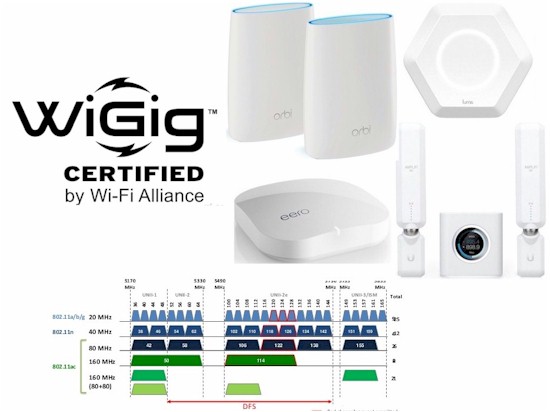
Read on SmallNetBuilder

I did not check the range limits of any of the mesh products tested.Thanks for your great article. I've been implementing a lot of eero's lately does Orbi have same coverage? Seems like from article it's backhaul is faster.
In reality, AD7200 routers are 4x4 AD2600 class routers with an 802.11ad radio tacked on.
Yep. Thanks for the catch. Fixed nowI assume that should be "4x4 AC2600 class routers".
Something worth mentioning perhaps is the Regulatory improvements seen with the 2016 products - While many are perhaps still a bit upset at the FCC about firmware, they also opened up additional channels and relaxed some power constraints which can have a definite impact on utility of the 5GHz band...
Do you mean something other than DFS?they also opened up additional channels
andIf you have a small area to cover and just a few devices, AC1200 class will suit you fine.
But there's no numerical value to quantify what are 'a lot' or 'few' devices and what is a large /small area. I understand that the area could vary due to walls and wall consturcion, but what could one expect? I also realize that the number may not be as important as how much each device is doing on the network. But maybe with some thought I'm sure there's a way to generalize (i.e. house of 4 people, small business with 8, coverage through 'n' interior walls, coverage through 'x' stucco walls with wire mesh, single story, two story, etc.)....if you have a lot of devices and a large area to cover, consider mesh systems..."
Do you mean something other than DFS?
The issues are still muddy for Europe. Some manufacturers will go with the lowest common denominator, despite the fact that some countries might allow for higher power output or for additional channels than the global EU regulations.
It's not always clear as to which regulation each manufacturer follows, what region they encode in the bootloader, etc... I assume that if someone in Europe were to do the same kind of testing Tim does, we might be seeing more variation between manufacturers than he can observe with US models (since North America pretty much runs all on that same region).
Wi-Fi doesn't lend itself to hard and fast rules. There are too many variables. But I'll try.But there's no numerical value to quantify what are 'a lot' or 'few' devices and what is a large /small area.
Music bitrates depend on the format. Always assume its a quality source so you wont need to put more than 2Mb/s for an mp4 recording.
Hey there Tim, I was wondering you said that future proofing is risky business so if I were to buy a router now, would it be better to go for 1900 or 2600?Our 2017 guide to choosing a wireless router reflects the changing Wi-Fi landscape.
Read on SmallNetBuilder
Hey there Tim, I was wondering you said that future proofing is risky business so if I were to buy a router now, would it be better to go for 1900 or 2600?

Welcome To SNBForums
SNBForums is a community for anyone who wants to learn about or discuss the latest in wireless routers, network storage and the ins and outs of building and maintaining a small network.
If you'd like to post a question, simply register and have at it!
While you're at it, please check out SmallNetBuilder for product reviews and our famous Router Charts, Ranker and plenty more!
